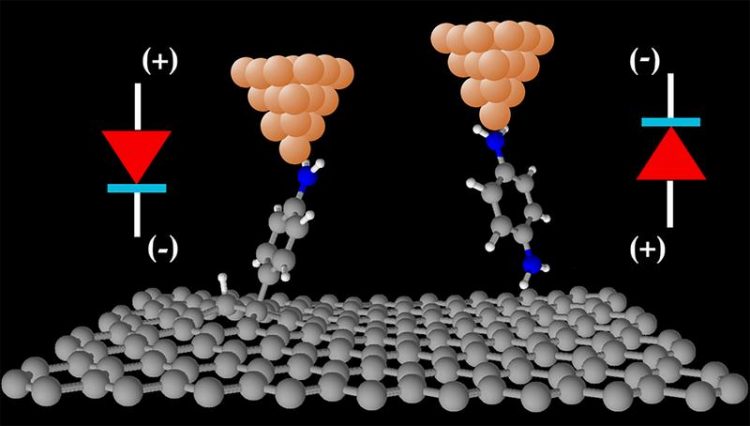Graphene electrodes offer new functionalities in molecular electronic nanodevices

Molecules covalently attached to graphene are ideal candidates for electronic devices. © Alexander Rudnev, University of Bern
The field of nanoscale molecular electronics aims to exploit individual molecules as the building blocks for electronic devices, to improve functionality and enable developers to achieve an unprecedented level of device miniaturization and control.
The main obstacle hindering progress in this field is the absence of stable contacts between the molecules and metals used that can both operate at room temperature and provide reproducible results. Graphene possesses not only excellent mechanical stability, but also exceptionally high electronic and thermal conductive properties, making the emerging 2D material very attractive for a range of possible applications in molecular electronics.
A team of experimentalists from the University of Bern and theoreticians from NPL (UK) and the University of the Basque Country (UPV/EHU, Spain), with the help of collaborators from Chuo University (Japan), have demonstrated the stability of multi-layer graphene-based molecular electronic devices down to the single molecule limit.
The findings, reported in the journal Science Advances, represent a major step change in the development of graphene-based molecular electronics, with the reproducible properties of covalent contacts between molecules and graphene (even at room temperature) overcoming the limitations of current state-of-the-art technologies based on coinage metals.
Connecting single molecules
Adsorption of specific molecules on graphene-based electronic devices allows device functionality to be tuned, mainly by modifying its electrical resistance. However, it is difficult to relate overall device properties to the properties of the individual molecules adsorbed, since averaged quantities cannot identify possibly large variations across the graphene’s surface.
Dr Alexander Rudnev and Dr Veerabhadrarao Kaliginedi, from the Department of Chemistry and Biochemistry at the University of Bern, performed measurements of the electric current flowing though single molecules attached to graphite or multi-layered graphene electrodes using a unique low-noise experimental technique, which allowed them to resolve these molecule-to-molecule variations.
Guided by the theoretical calculations of Dr Ivan Rungger (NPL) and Dr Andrea Droghetti (UPV/EHU), they demonstrated that variations on the graphite surface are very small and that the nature of the chemical contact of a molecule to the top graphene layer dictates the functionality of single-molecule electronic devices.
“We find that by carefully designing the chemical contact of molecules to graphene-based materials, we can tune their functionality,” said Dr Rungger. “Our single-molecule diodes showed that the rectification direction of electric current can be indeed switched by changing the nature of chemical contact of each molecule,” added Dr Rudnev.
“We are confident that our findings represent a significant step towards the practical exploitation of molecular electronic devices, and we expect a significant change in the research field direction following our path of room-temperature stable chemical bonding,” summarized Dr Kaliginedi. The findings will also help researchers working in electro-catalysis and energy conversion research design graphene/molecule interfaces in their experimental systems to improve the efficiency of the catalyst or device.
Publication details:
Alexander V. Rudnev, Veerabhadrarao Kaliginedi, Andrea Droghetti, Hiroaki Ozawa, Akiyoshi Kuzume, Masa-aki Haga, Peter Broekmann, Ivan Rungger: Stable anchoring chemistry for room temperature charge transport through graphite-molecule contacts, Science Advances, 9 June 2017, in press.
Contact:
Dr. Alexander Rudnev
Department of Chemistry and Biochemistry, University of Bern
Phone: +41 31 631 42 54
Email: alexander.rudnev@dcb.unibe.ch
Media Contact
More Information:
http://www.unibe.chAll latest news from the category: Materials Sciences
Materials management deals with the research, development, manufacturing and processing of raw and industrial materials. Key aspects here are biological and medical issues, which play an increasingly important role in this field.
innovations-report offers in-depth articles related to the development and application of materials and the structure and properties of new materials.
Newest articles

Compact LCOS Microdisplay with Fast CMOS Backplane
…for High-Speed Light Modulation. Researchers from the Fraunhofer Institute for Photonic Microsystems IPMS, in collaboration with HOLOEYE Photonics AG, have developed a compact LCOS microdisplay with high refresh rates that…

New perspectives for material detection
CRC MARIE enters third funding period: A major success for terahertz research: Scientists at the University of Duisburg-Essen and the Ruhr University Bochum have been researching mobile material detection since…

CD Laboratory at TU Graz Researches New Semiconductor Materials
Using energy- and resource-saving methods, a research team at the Institute of Inorganic Chemistry at TU Graz aims to produce high-quality doped silicon layers for the electronics and solar industries….



